Trolltunga
Trolltunga (English: Troll tongue) is a rock formation situated about 1,100 metres (3,600 ft) above sea level in Ullensvang Municipality in Vestland county, Norway. The cliff juts horizontally out from the mountain, about 700 metres (2,300 ft) above the north side of the lake Ringedalsvatnet.[2]
| Trolltunga | |
|---|---|
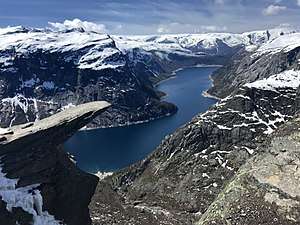 The view of Trolltunga and Ringedalsvatnet with glimpses of the Folgefonna glacier in the background. | |
| Highest point | |
| Elevation | 1,100 m (3,600 ft) |
| Coordinates | 60°07′51″N 6°45′15″E[1] |
| Naming | |
| English translation | Troll tongue |
| Language of name | Norwegian |
| Geography | |
 Trolltunga Location of the mountain  Trolltunga Trolltunga (Norway) | |
| Location | Vestland, Norway |
| Topo map | Hardangervidda Vest (2010) |
| Geology | |
| Mountain type | Granite penetrated by glacial erosion |
| Climbing | |
| Easiest route | Challenging |
Popularity of the hike to Trolltunga and rock formation itself has exploded in recent years. The increased popularity has turned Trolltunga into a national icon and a major tourist attraction for the region. Until 2010, fewer than 800 people hiked to Trolltunga each year. In 2016 more than 80,000 people hiked[3] the 27-kilometre (17 mi) round-trip from the village of Skjeggedal, making it one of Norway's most popular hikes.[4]
This is a very challenging hike, at least 10 hours on rough terrain. There are no shelters on the hike route and no places to buy supplies. However, there is a plan to build a lodge roughly halfway where hikers can rest.
Geology
The cliff is part of the Precambrian bedrock and was formed during the Ice Age, approximately 10,000 years ago, when the edges of the glacier reached the cliff. The water from the glacier froze in the crevices of the mountain and eventually broke off large, angular blocks, which were later carried away with the glacier. Along the cliff itself, a gneiss, there continues to be deep cracks. The trail to Trolltunga also passes through the bedrock and washed slippery hillsides in the background also containing gneiss.
Access
Trolltunga is located 17 kilometres (11 mi) from the town of Odda. The city of Bergen, is about 190 kilometres (120 mi) from the site via main roads.
The trailhead is located by a small parking area with toilet facilities at Skjeggedal, about 7 kilometres (4.3 mi) from Norwegian National Road 13 in Tyssedalen, near the dam at the end of Ringedalsvatnet. Parking costs 500 kr per day for the lower car park (approx. 62 USD[5] or 52 EUR[6]).
The hike from the parking area to Trolltunga and back again is a 27-kilometre (17 mi) round-trip distance with a 1,100-metre (3,600 ft) gain in elevation, and it takes approximately 10–12 hours, including breaks.
Hiking trail

Near the parking area at Skjeggedal there is a funicular called Mågelibanen (it is not in operation). The trail to Trolltunga begins here, on the left side of the funicular. It is marked with red Ts painted in the terrain, and signs along the route that marks the distance left to Trolltunga and to the starting point at Skjeggedal.
For the first 1.5 kilometres (0.93 mi), up to the Måglitopp, the trail rises about 450 metres (1,480 ft). From here the track surfaces slightly out before it gets steep again, rising another 330 metres (1,080 ft) up from Gryteskaret to Trombåskåret. This section is the steepest part on this hike. But in recent years this section have been improved by Nepalese sherpas, making it easier to traverse.
After this 4-kilometre (2.5 mi) steep climb from the parking area, the next section slopes down towards Store Floren. The trail continues over Hesteflåene and the dried out river Endåno, before it gets steeper up to Endanuten and crosses the dried river to Tyssestrengene. From here the trail goes on past glacial potholes, then continues past Tysshøl, and finally approaches Trolltunga, about 13.5 kilometres (8.4 mi) from the starting point at Skjeggedal.
Alternative starting point
In 2017, a new toll road up the steep hillside to Mågelitopp opened to the public. It allows vehicles to access the plateau at Måglitopp. It does not require a 4x4 vehicle. Due to limited parking the maximum capacity here is 30 cars per day. The road opens each day during the season at 6:00 AM, and closes when the first 30 cars have entered the gate. Online reservations are possible and parking here costs 600 kr The road is also open to hikers, as an alternative to the regular starting point at Skjeggedal.
Terrain
.jpg)
The route to Trolltunga goes through high mountain terrain with creeks, streams, boulders, mud puddles, marshes, and water at several spots on the hike.
From late-September to June the terrain is normally covered with ice and snow. After a hard winter it can be snow at Trolltunga even during the summer season.
Seasons and climate
Trolltunga is accessible for experienced hikers and guided groups from mid-June to mid-September, depending on when the snow melts in the Spring. The season for guided trips with snowshoes or skis starts in March.
Trolltunga is located in a region with a mild and humid coastal climate. During summer and autumn the weather conditions often change quickly – from blue sky to wind, rain and dense fog. Check the weather forecast and ask locals about what kind of weather to expect before you go hiking.
Due to the long distance, hikers to Trolltunga need to start before 10:00 AM in the summer season[2] to get home before it gets dark and cold. In September it is recommended to start 8:00 AM at latest, since it gets darker earlier in the evening.
Degree of difficulty
The Norwegian Trekking Association classify the hike as "challenging", requiring good endurance as well as proper hiking boots and equipment.
Safety
Thousands of tourists visit Trolltunga during the four summer months, a number which has greatly increased from 500 per year to 80,000 between 2009 and 2016. No safety railing has been constructed on the edge of the cliff so as not to harm the natural beauty of the cliff, although a few small metal hooks have been installed as footholds to climb down to the rock.
On 5 September 2015, a 24-year-old Australian woman fell to her death off Trolltunga. It is believed to be the first recorded death from a fall there.[7][8][9]
There are highly spread photos of people hanging the cliff or doing a hand stand on it. Most often they are manipulated. The elite climber Magnus Midtbø suspended himself from Trolltunga wearing a safety harness, but a version where the rope was erased has been spread in media.[10]
The approach to and retreat from Trolltunga is a demanding hike, and 10–12 hours are needed for the round trip. In later years there have been up to 40 rescue actions annually. Surprisingly not because of the dangerous cliff, but due to the demanding hike back to Tyssedal. People get lost in fog or get injured during the hike or don't have the endurance for such a demanding hike.[11]
It is planned to build a lodge halfway between Trolltunga and Tyssedal, which will provide accommodation for hikers en route from Trolltunga.
Surrounding landscape
The cliff overlooks the valleys of the Hardanger region. The mountains surrounding the cliff reach heights of up to 1500 meters. Some of the hilltops have plains which are interspersed with lakes. Patches of snow are present in some areas, even in the summer months. Due to heavy use by tourists, the trail to Trolltunga quickly turns to mud after a rain in the summer.
Gallery
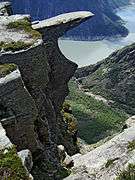 'Trolltunga' in Odda
'Trolltunga' in Odda- Lunar landscape of 'Jettegryter', Glacial potholes, nearby 'Trolltunga'
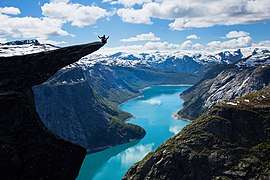 Trolltunga cliff
Trolltunga cliff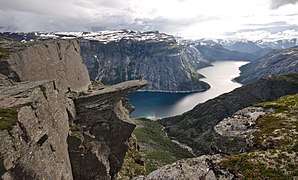 View of Trolltunga
View of Trolltunga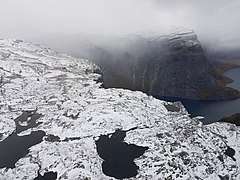 View of Trolltunga from the air in early October
View of Trolltunga from the air in early October
See also
- Kjerag
- Kjeragbolten
- Preikestolen
- Trollgaren
- De syv søstre
- Trollveggen
- Trollstigen
- Besseggen
- List of waterfalls
- National parks of Norway
References
- "Trolltunga, Ullensvang (Vestland)" (in Norwegian). yr.no. Retrieved 2020-03-01.
- Faltin, Tine (14 September 2013). "Jeg har møtt turister som reiser hit på helgetur fra New York og Korea. Stor kåring: To av verdens ti beste fotturer ligger i Norge" (in Norwegian). Dagbladet. Retrieved 12 October 2013.
- NRK. "Her reddes turistene ned etter 14 timer på fjellet". NRK (in Norwegian). Retrieved 2017-06-27.
- "How to hike Norway's most famous mountains in three days". The Telegraph. Retrieved 2017-06-27.
- "XE: Convert NOK/USD. Norway Krone to United States Dollar". www.xe.com. Retrieved 2018-06-25.
- "XE: Convert NOK/EUR. Norway Krone to Euro Member Countries". www.xe.com. Retrieved 2018-06-25.
- "Trolltunga photos removed after fatal fall". Stuff.co.nz. 2015-09-14. Retrieved 2015-09-27.
- "Kvinne i 20-årene døde etter fall fra Trolltunga - Aftenposten". Aftenposten.no. 2014-01-31. Retrieved 2015-09-27.
- "Mother of Kristi Kafcaloudis mourns loss of 'beautiful soul' who died in 300-metre cliff fall in Norway". ABC News. Australian Broadcasting Corporation. 8 September 2015. Retrieved 8 September 2015.
- Magnus (27) henger fra Trolltunga
- Why Norwegians are teaching travellers to travel, bbc.com
External links
- Trolltunga.com Official site
- Hiking Trolltunga from Odda Tourist Office
- About Trolltunga from Fjord Norway, the official tourist board of Western Norway
- Trolltunga Road Information about the toll road from Skjeggedal to Mågelitopp